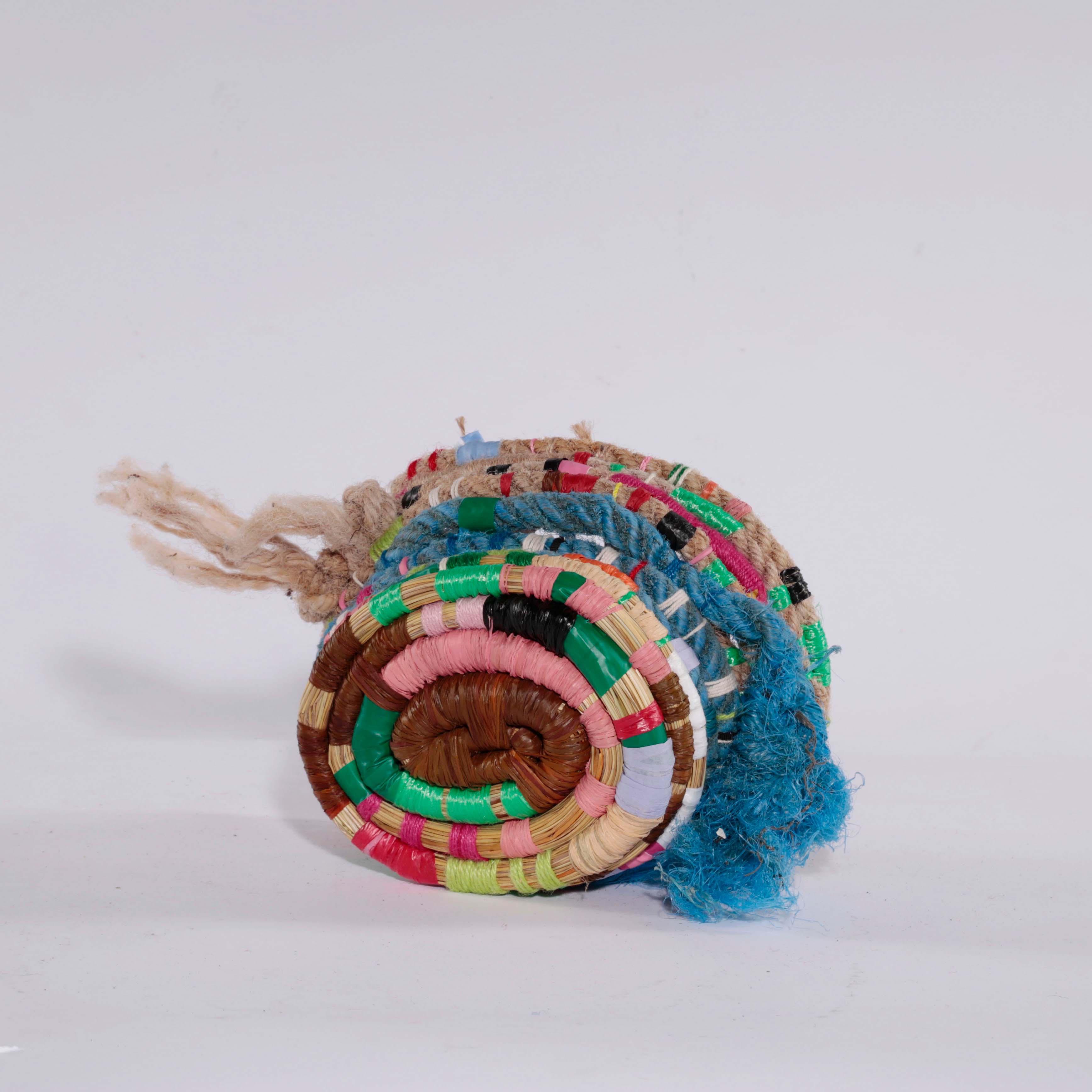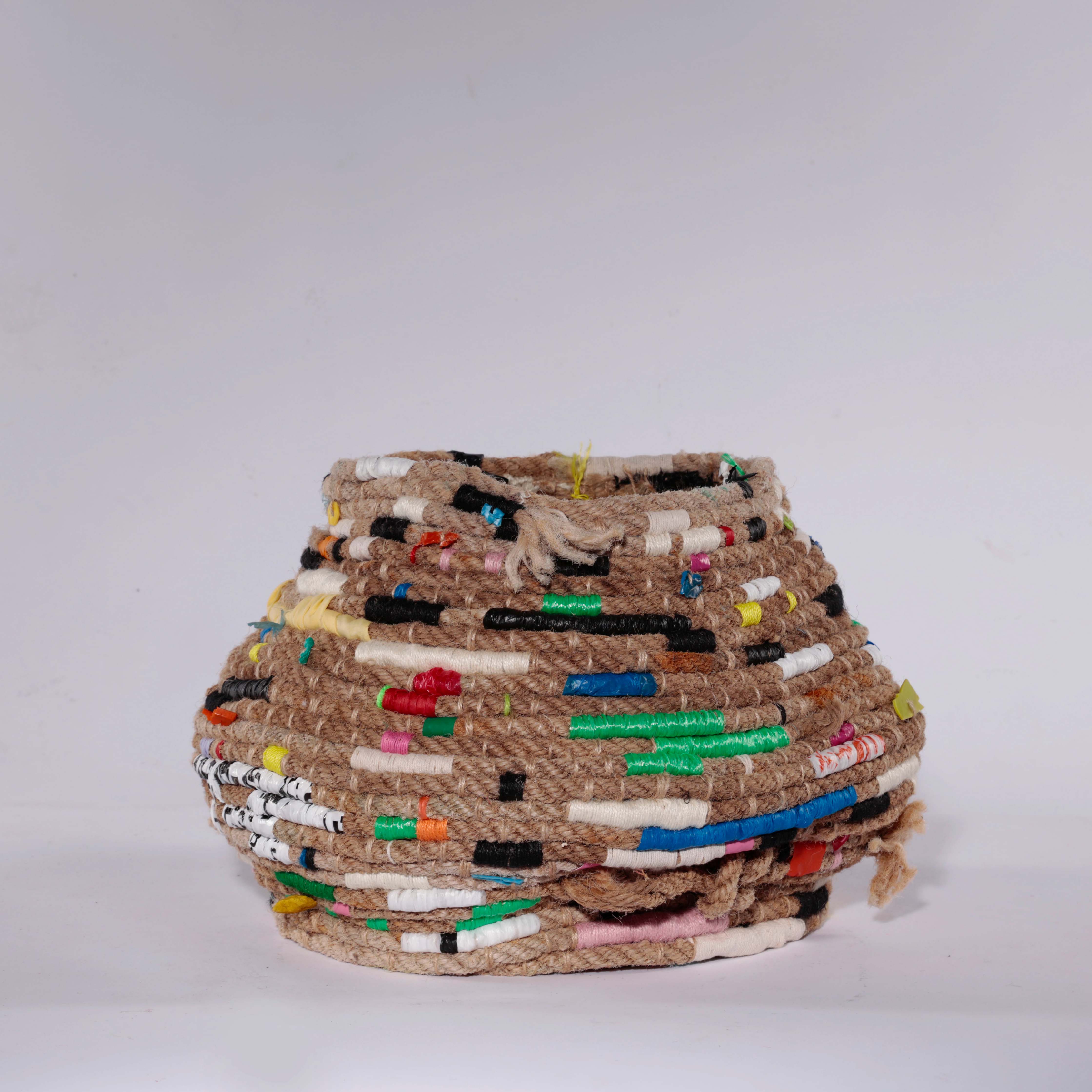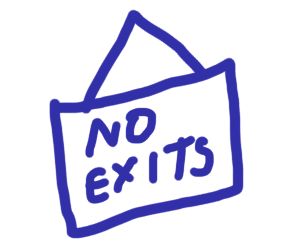June 2023

Kaye Bonnar, Marrams, 2022. Courtesy the artist
In a gallery space near London Fields, Kaye Bonnar, a self-proclaimed non-functional basket maker, sat down with Jade Cowans, one half of TWG/THEWHOGALLERY duo, to discuss her practice and evolving relationship with the many stratas of the visual arts world. Since her years at Grays School of Art, Bonnar has grappled with the labels associated with being a maker and those assumed contexts which accompany them. Working in a time when craft and fine art appear as opposing ends of the binary, where does traditional technique factor into the world of the white cube?
The following is an interview with the artist, delving into her own journey with accepting creative labeling and the methods which deepened her creative practice.
Jade Cowans: How long have you called yourself an artist or maker? And how long have you felt comfortable owning that title?
Kaye Bonnar: Just relatively recently, maybe within the last two years. It was kind of during my masters at the Royal College of Art. We were prompted to put our work within a context such as a specific space, interior, gallery. I was emotionally enticed by ‘gallery’ but was like am I? It almost felt a bit daunting because I didn’t see myself as a fine artist. It feels like an elitist area to be in, but I decided because I was in an era of experimentation, that I was going to go for it and see what happens. It was during that time that I had a turning point where I felt like ‘I am an artist’ and my work can be within the context of the ‘gallery’. I started, then, calling myself both an artist and a maker. I feel like craft is overlooked in the art realm, as if it is seen as less than. I feel like craft needs to be acknowledged more within the context of the gallery.
The work you allude to gravitates towards found objects or objects you can reuse within your work. Where did this practice begin?
That also came from the time of the pandemic. I hate having to talk about Covid and the pandemic but that had a lot to do with where my work is at now because I had to improvise and learn techniques. I had to discover what my practice could become because I had chosen to specialise in weave to learn the traditional technique. It was my task to understand the concept of weaving off of the loom because I couldn’t have access to one. So then I started learning about basketry and at the same time, discovered a photo of my nana, who is my grandma’s mum, weaving a basket. It felt like it came together at the right time, like I was connecting to my heritage of making.
That all happened alongside finding materials, which I didn’t have as much access to, while also realising that I am a bit of a hoarder as I keep buttons and bits of paper, like wrapping paper I really like the colour of. I actually have all of this stuff I haven’t put to use because I liked how it looked and didn’t feel like it should be thrown out. I started to incorporate these things into my work and actively looked into reusing everyday materials. It kind of aligns: craft being overlooked and the materials I am using are being overlooked as well.
Using things I would find – things I already had – led me to seeing rope. I was spending a lot of time at home in Scotland and was walking on the beach a lot. There's this excess of discarded rope on that beach which I started to collect for material while discovering these basketry techniques. I incorporated binding them together with old string or old yarn I have in a box or plastic bags I kept from the shop.
The following is an interview with the artist, delving into her own journey with accepting creative labeling and the methods which deepened her creative practice.
Jade Cowans: How long have you called yourself an artist or maker? And how long have you felt comfortable owning that title?
Kaye Bonnar: Just relatively recently, maybe within the last two years. It was kind of during my masters at the Royal College of Art. We were prompted to put our work within a context such as a specific space, interior, gallery. I was emotionally enticed by ‘gallery’ but was like am I? It almost felt a bit daunting because I didn’t see myself as a fine artist. It feels like an elitist area to be in, but I decided because I was in an era of experimentation, that I was going to go for it and see what happens. It was during that time that I had a turning point where I felt like ‘I am an artist’ and my work can be within the context of the ‘gallery’. I started, then, calling myself both an artist and a maker. I feel like craft is overlooked in the art realm, as if it is seen as less than. I feel like craft needs to be acknowledged more within the context of the gallery.
The work you allude to gravitates towards found objects or objects you can reuse within your work. Where did this practice begin?
That also came from the time of the pandemic. I hate having to talk about Covid and the pandemic but that had a lot to do with where my work is at now because I had to improvise and learn techniques. I had to discover what my practice could become because I had chosen to specialise in weave to learn the traditional technique. It was my task to understand the concept of weaving off of the loom because I couldn’t have access to one. So then I started learning about basketry and at the same time, discovered a photo of my nana, who is my grandma’s mum, weaving a basket. It felt like it came together at the right time, like I was connecting to my heritage of making.
That all happened alongside finding materials, which I didn’t have as much access to, while also realising that I am a bit of a hoarder as I keep buttons and bits of paper, like wrapping paper I really like the colour of. I actually have all of this stuff I haven’t put to use because I liked how it looked and didn’t feel like it should be thrown out. I started to incorporate these things into my work and actively looked into reusing everyday materials. It kind of aligns: craft being overlooked and the materials I am using are being overlooked as well.
Using things I would find – things I already had – led me to seeing rope. I was spending a lot of time at home in Scotland and was walking on the beach a lot. There's this excess of discarded rope on that beach which I started to collect for material while discovering these basketry techniques. I incorporated binding them together with old string or old yarn I have in a box or plastic bags I kept from the shop.

Kaye Bonnar, Phaedra, 2022. Courtesy the artist
With you, both from yourself but also the pieces you have found, you are weaving together these different life stories into a new object.
I do like that the things I use have had a previous life and story and it shows on the material. Often they are quite worn and are rusted or colours change as if they have been bleached by the sun or weathered by the sea. I like that. I don’t try to hide that. I like showing the imperfections rather than using the materials and trying to make everything perfect. I like accentuating the imperfections of them because it’s already had that previous life.
Why is it important to you to not hide the flaws?
I think because I find it more interesting to look at. I feel like it’s good to look at things that already exist rather than something shiny and new. I find that much less interesting than something that is worn away and dishevelled because of something it’s gone through. I think it gives more history to the material and it’s probably changed in a way you couldn’t try to do or replicate, it’s a one off. It’s been crumpled a certain way or been stepped on and gone through something you can’t recreate.
Also with the materials I have to work with, I love colour. Colour is a huge thing for me. My mum’s a painter and she says that when she was working with a mentor, he told her she just has this connection with colour that can’t be taught. It’s something she has. And my mum told me I have that. It’s this relationship with colour that feels innate. So I like having all of this random material and having to work with what is there and creating these interesting combinations. Like how this blue goes with that orange. It’s nice working with materials that are there. You don’t have all of these options but you are creating something different with the combinations and how you are putting them together.
You have these systems and constructs in place and can look at them and think ‘Oh, I’m really restricted,’ or you can look at it as ‘I can still manoeuvre and do what I want to do.’
I can’t remember the artist, but I watched this documentary and they were saying that having restrictions pushes you to become more creative. Having less access to materials, whether it is to do with money or whatever reason, actually pushes you to be more creative because if everything is to hand, you can do anything. But if you have only this, this, and this, the question is: what can I make with it? You have to be pushed in your thought process.
Thinking towards the future, what excites you about this journey you're on with these found objects?
Where I can go with it. I really am just at the beginning of it. At the moment I am working with traditional basketry structures. They don't look perfect because of how I’ve said I work with the material but you can tell it's a basket. I do like keeping it that way because it is showing my views on how I feel craft is overlooked. Also there’s an aspect of gender stereotypes where I feel like if a woman is making a basket it's expected but if a man were to make a basket would it be more likely to be recognized as an artistic form of expression.
Moving forward, I plan to explore different scales and structures. It could go out of the realm of traditional basketry forms as I learn more about the process and work with more materials. I have been focusing a lot on the materials I find on the beach in Scotland which I love because it is connected to my heritage but I am based in London and have lived here for a long time so I also want to explore materials from elsewhere. I can make different series with different materials which will lead to those different forms and structures.
With you, both from yourself but also the pieces you have found, you are weaving together these different life stories into a new object.
I do like that the things I use have had a previous life and story and it shows on the material. Often they are quite worn and are rusted or colours change as if they have been bleached by the sun or weathered by the sea. I like that. I don’t try to hide that. I like showing the imperfections rather than using the materials and trying to make everything perfect. I like accentuating the imperfections of them because it’s already had that previous life.
Why is it important to you to not hide the flaws?
I think because I find it more interesting to look at. I feel like it’s good to look at things that already exist rather than something shiny and new. I find that much less interesting than something that is worn away and dishevelled because of something it’s gone through. I think it gives more history to the material and it’s probably changed in a way you couldn’t try to do or replicate, it’s a one off. It’s been crumpled a certain way or been stepped on and gone through something you can’t recreate.
Also with the materials I have to work with, I love colour. Colour is a huge thing for me. My mum’s a painter and she says that when she was working with a mentor, he told her she just has this connection with colour that can’t be taught. It’s something she has. And my mum told me I have that. It’s this relationship with colour that feels innate. So I like having all of this random material and having to work with what is there and creating these interesting combinations. Like how this blue goes with that orange. It’s nice working with materials that are there. You don’t have all of these options but you are creating something different with the combinations and how you are putting them together.
You have these systems and constructs in place and can look at them and think ‘Oh, I’m really restricted,’ or you can look at it as ‘I can still manoeuvre and do what I want to do.’
I can’t remember the artist, but I watched this documentary and they were saying that having restrictions pushes you to become more creative. Having less access to materials, whether it is to do with money or whatever reason, actually pushes you to be more creative because if everything is to hand, you can do anything. But if you have only this, this, and this, the question is: what can I make with it? You have to be pushed in your thought process.
Thinking towards the future, what excites you about this journey you're on with these found objects?
Where I can go with it. I really am just at the beginning of it. At the moment I am working with traditional basketry structures. They don't look perfect because of how I’ve said I work with the material but you can tell it's a basket. I do like keeping it that way because it is showing my views on how I feel craft is overlooked. Also there’s an aspect of gender stereotypes where I feel like if a woman is making a basket it's expected but if a man were to make a basket would it be more likely to be recognized as an artistic form of expression.
Moving forward, I plan to explore different scales and structures. It could go out of the realm of traditional basketry forms as I learn more about the process and work with more materials. I have been focusing a lot on the materials I find on the beach in Scotland which I love because it is connected to my heritage but I am based in London and have lived here for a long time so I also want to explore materials from elsewhere. I can make different series with different materials which will lead to those different forms and structures.

Kaye Bonnar, Ace of cups, 2022. Courtesy the artist
Kaye Bonnar is a Scottish textile maker and artist. Kaye’s work is led by the desire to highlight the importance of craft and making by hand as a notable art form, often referencing her heritage and traditional self taught crafts, with a particular focus on basketry. Kaye studied Textiles MA at the Royal College of Art and is now based in Deptford at the Cockpit Arts Studios through the Basketmakers’ Award.
Jade Cowans is a London based artist and creative consultant. Her work has been featured on Dazed Digital, Complex, Tate and Riposte Magazine. She also part runs TWG/THEWHOGALLERY, curating and exhibiting artists across London and beyond.
Jade Cowans is a London based artist and creative consultant. Her work has been featured on Dazed Digital, Complex, Tate and Riposte Magazine. She also part runs TWG/THEWHOGALLERY, curating and exhibiting artists across London and beyond.
